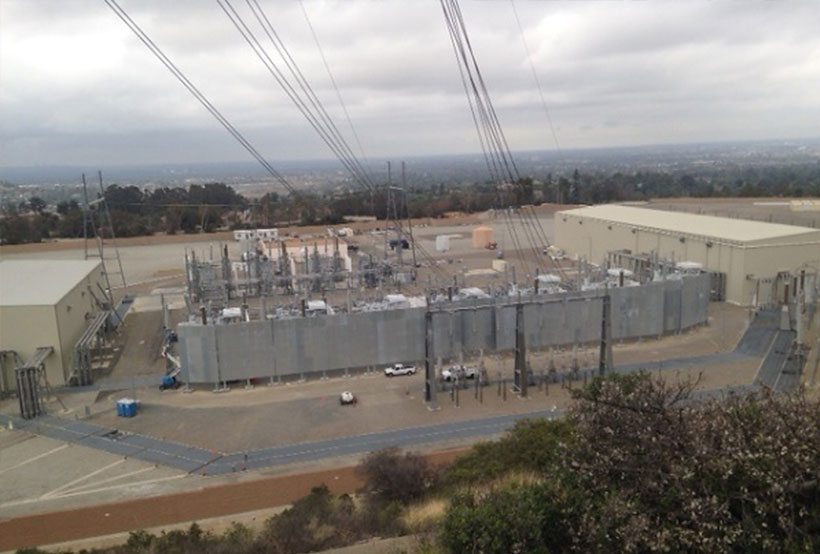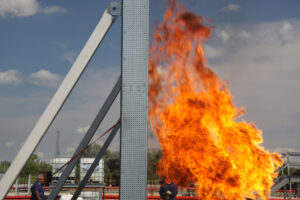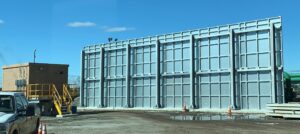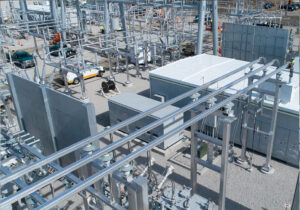Transformer fire barriers prevent electrical grid failures by protecting transformers from fire damage. A fire in a transformer can quickly spread, causing major outages. Fire barriers act as shields, containing the fire and reducing damage. This prevents widespread grid failure and keeps electricity flowing without interruption. Read on to learn about the importance of fire barrier services.
How Transformer Fire Barriers Work
Containing Fire and Heat
Fire barriers are made to stop fires from spreading. When a transformer catches fire, the barrier keeps the flames from reaching nearby equipment. It traps the heat, stopping it from causing more damage. These barriers are built using materials that resist extreme heat. They help keep the fire contained in one area, preventing it from moving to other parts of the grid. This is important because fires can quickly get out of control. The barrier’s job is to isolate the fire and stop it from spreading to nearby transformers and wires.
Stopping Short-Circuits
Fire barriers play a big role in preventing short-circuits. If a transformer gets damaged and sparks fly, it can cause a short-circuit. A short-circuit can lead to power outages and safety hazards. The barrier helps by isolating the faulty transformer. By doing this, it stops the short-circuit from reaching other equipment. This keeps the electrical grid from going down. It also prevents damage to surrounding equipment, which could be costly to repair. The barrier makes sure that a single failure doesn’t cause a bigger problem across the grid.
The Role of Fire Barriers in Grid Protection
Limiting System-wide Failures
Fire barriers play an important role in preventing widespread damage. When a fire starts in one area, the barrier contains it and stops it from spreading. This prevents the fire from affecting the entire system. By isolating the fire, only localized damage happens. The rest of the grid stays safe and continues to operate. Without the barriers, a small fire could cause major outages across the grid. The barrier helps control the damage and keeps the electrical flow intact, allowing for faster repairs and less disruption.
Improving System Reliability
Fire barriers improve the reliability of the electrical grid. When fires are contained, there’s less risk of failures spreading. The grid can keep working smoothly without cascading failures. This makes the system more stable and reliable. With barriers in place, even if a transformer catches fire, it doesn’t affect other parts of the grid. The reliability of the system improves, and service interruptions are less common. Barriers give the grid a better chance to keep performing well, even in the face of equipment failures.
Different Types of Transformer Fire Barriers
Passive Fire Barriers
Passive fire barriers are designed to stay in place without needing any power. These barriers are made from materials that resist high temperatures and prevent fires from spreading. They do not require any moving parts or electricity to function. Once installed, they work continuously, protecting transformers from fire damage. Because they are static, these barriers are simple and reliable. They are a low-maintenance option for long-term protection. Passive fire barriers are often used in areas where a constant, reliable solution is needed to protect the equipment.
Active Fire Barriers
Active fire barriers react to heat. When a fire is detected, these barriers automatically close or activate. They are equipped with sensors that monitor temperature changes. As soon as a fire is sensed, the barrier quickly activates to contain the flames. Active barriers are more dynamic and respond to specific conditions. This makes them a great choice for environments where fire risks can vary. These barriers are typically used when quick action is needed to stop a fire from spreading to other equipment or areas of the grid.
The Lifespan and Durability of Fire Barriers
Long-Lasting Protection
Fire barriers are designed to last many years. They are made of tough materials that can resist extreme heat. Once they are installed, they protect transformers from fire damage. These barriers are built to provide protection over time. Their strong design ensures that they can handle harsh conditions. Fire barriers keep the grid safe without needing frequent repairs. This makes them a low-maintenance option for electrical systems. The durability of these barriers means fewer replacements. They are an excellent long-term investment for keeping electrical systems protected from fire hazards.
Minimal Maintenance Required
The fire barriers we install need very little maintenance. After installation, they continue to protect transformers for years. These barriers are designed to last without frequent repairs. They can handle extreme temperatures and tough conditions. The barriers we install require no maintenance for 50 years. This makes them a low-maintenance option for any electrical grid. Occasional checks may help, but no regular upkeep is needed. This reduces time spent on repairs. Fire barriers provide a reliable, hassle-free solution. With minimal attention required, they save time and money for grid owners.
Benefits of Using Fire Barriers in Electrical Systems
Reducing Downtime
Fire barriers play a key role in reducing downtime. When a fire occurs in a transformer, it can quickly lead to widespread outages. Fire barriers contain the fire, stopping it from spreading to other parts of the system. This prevents major damage to equipment, allowing the grid to keep functioning. By isolating the fire to one area, repairs can begin faster. This minimizes the impact on the grid and keeps the electrical system running. With fire barriers in place, the time spent on restoring power is reduced, helping keep systems operational.
Lowering Operational Costs
Fire barriers help lower operational costs by preventing major grid failures. Fires in transformers can cause significant damage and require costly repairs. With fire barriers, the risk of a large-scale failure is greatly reduced. This helps keep repair costs down and limits the impact on the grid. Fire barriers contain fires before they can spread, preventing the need for expensive repairs. By reducing the likelihood of outages, they help keep electricity flowing without interruption. This leads to lower overall costs for grid operators, making fire barriers a cost-effective solution.
Protecting Grids with Fire Barriers by Sinisi Solutions
Transformer fire barriers prevent grid failures by containing fires before they can spread to important components. These barriers help reduce costly downtime and maintain smooth operations by keeping electrical systems safe from fire damage. Fire barriers provide reliable protection without the need for constant maintenance. At Sinisi Solutions, we offer reliable fire barrier services to keep your grid safe and running. Contact us today to learn how we can help safeguard your infrastructure and minimize the risks of electrical failures.




